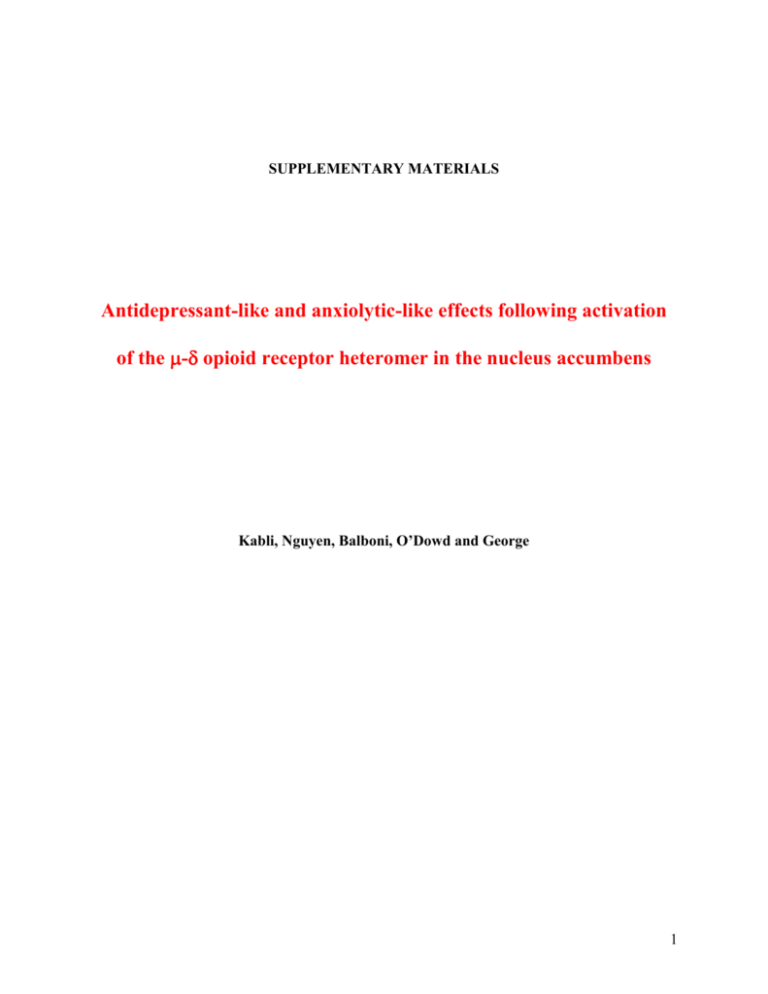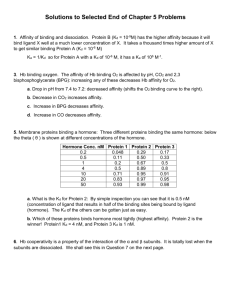Supplementary Information (doc 59K)
advertisement

SUPPLEMENTARY MATERIALS Antidepressant-like and anxiolytic-like effects following activation of the - opioid receptor heteromer in the nucleus accumbens Kabli, Nguyen, Balboni, O’Dowd and George 1 LIST OF SUPPLEMENTARY MATERIALS Figure S1. Effect of the OR carboxyl tail peptide minigene on -agonist SNC80 modulation of µ-agonist binding to, and internalization of, the -OR heteromer. Table S1. Effect of the OR carboxyl tail peptide minigene on -agonist binding to the receptor ligand binding pocket within the -OR heteromer. Table S2. Effect of the OR carboxyl tail peptide minigene on - and -agonist binding to the -receptor ligand binding pocket in the OR homomer or on -agonist binding to the -receptor ligand pocket within the OR homomer. Figure S2. Cannula placement in the rat nucleus accumbens core Figure S3. Dose response curves of UFP-512’s antidepressant-like effects in the forced swim test following intra-accumbens administration. Figure S4. Dose response curves of UFP-512’s anxiolytic-like and antidepressant-like effects in the novelty-induced hypophagia test following intracerebroventricular administration. Figure S5. Effect of the -agonist UFP-512 on analgesia in the tail immersion nociceptive assay. Figure S6. Effect of the -agonist UFP-512 or TAT-conjugated peptides on locomotor activity. Supplementary Methods References 2 Supplemental Figure 1. Effect of the OR carboxyl tail peptide minigene on -agonist SNC80 modulation of µ-agonist binding to, and internalization of, the -OR heteromer. Binding (A-C): SNC80 -agonist detection of the ligand binding pocket using the µ-agonist [3H]-DAMGO in cells co-expressing - and -OR in the absence or presence of the interfering (A) or control peptide minigene (B), or in cells expressing OR alone (C). Grey and black arrowheads point to the high and low ligand binding affinities, respectively. An F-test was used to compare the coefficients of the goodness-of-fit and to determine whether a two-site (biphasic competition curve with high and low affinity sites) or a one-site (monophasic competition curve with one high or low affinity site) analysis was a statistically significant better fit for the radioligand competition binding curves. Results shown are mean + S.E.M. and curves are representative of n = 3-6 experiments performed in duplicate. Internalization (D): SNC80 agonist-induced internalization of cell surface OR in cells co-expressing - and -ORs in the absence and presence of the interfering peptide minigene or pre-treatment with either the antagonist naltrindole (NALT) or the µ-antagonist CTOP, or in cells expressing OR alone. Agonist-induced reduction in [3H]-DAMGO labeling in intact HEK 293T served as an index of OR internalization. Data shown represent drug-induced loss of cell surface receptors as a percentage of cell surface receptors in vehicle-treated control cells, and are expressed as mean + S.E.M. for n = 3-4 experiments performed in triplicate. 3 Supplemental Table 1. Effect of the OR carboxyl tail peptide minigene on -agonist modulation of µ-agonist binding to the -OR heteromer -OR KH (nM) KL (nM) % HA 85 + 21 24 + 2.0 UFP-512 0.5 + 0.1 SNC80 12 + 2.4 27,374 + 6775 45 + 2.9 -OR + PEP OR KI (nM) KI (nM) 79 + 7.2 16,809 + 4125 -OR + CTRL PEP KH (nM) KL (nM) % HA 83 + 3.1 0.7 + 0.2 77 + 17 22 + 3.7 13,111 + 1835 11 + 3.1 15,056 + 4981 44 + 7.6 -agonist detection of the ligand binding pocket in cells co-expressing - and -OR in the absence or presence of the inhibitory or control peptide minigene, or in cells expressing OR alone. Competition radioligand binding was performed using [3H]-DAMGO. Values shown represent mean + S.E.M. of n = 3 – 6 experiments performed in duplicate. KI = agonist-detected affinity site binding constant, KH = agonist-detected high affinity site binding constant, KL = agonist-detected low affinity site binding constant, % HA = percentage of receptors in the agonist-detected high affinity state. KI values are provided when single affinity binding sites are detected. An F-test was used to compare the coefficients of the goodness-of-fit and to determine whether a two-site (high and low affinity sites) or a one-site (one high or low affinity site) analysis was a statistically significant better fit for the radioligand competition binding curves. 4 Supplemental Table 2. Effect of the OR carboxyl tail peptide minigene on - and -agonist modulation of µ-agonist binding to the µOR homomer and -agonist binding to the OR homomer. OR OR + PEP KI (nM) KI (nM) UFP-512 83 + 3.1 DAMGO 7.4 + 0.2 82 + 10 7.7 + 0.2 OR KH (nM) KL (nM) OR + PEP % HA KH (nM) KL (nM) % HA 0.7 + 0.1 781 + 18 58 + 2.0 0.6 + 0.1 495 + 186 50 + 4.3 n/a n/a n/a n/a n/a n/a Agonist detection of the or ligand binding pocket in OR- or OR-expressing cells, respectively, in the absence or presence of the inhibitory peptide minigene. Competition radioligand binding was performed using [3H]-DAMGO in cells expressing µOR or [3H]diprenorphine in cells expressing OR. Values shown represent mean + S.E.M. of n = 3 experiments performed in duplicate. K I = agonist-detected affinity site binding constant, KH = agonist-detected high affinity site binding constant, KL = agonist-detected low affinity site binding constant, % HA = percentage of receptors in the agonist-detected high affinity state. K I values are provided when single affinity binding sites are detected. An F-test was used to compare the coefficients of the goodness-of-fit and to determine whether a two-site (high and low affinity sites) or a one-site (one high or low affinity site) analysis was a statistically significant better fit for the radioligand competition binding curves. 5 Supplemental Figure 2. Cannula placement in the rat nucleus accumbens core. Schematic representation of micro-injection sites into the nucleus accumbens core (filled circles). Each dot represents a cannula placement in the nucleus accumbens; one dot is used despite overlap in the location of the cannulae. Co-ordinates are relative to Bregma according to the Atlas of Paxinos and Watson (1). Supplemental Figure 3. Dose response curves of UFP-512’s antidepressant-like effects in the forced swim test following intra-accumbens administration. Rats were micro-injected bilaterally into the NAc with either saline or various doses of UFP-512. Rat behavior was scored, whereby the predominant behavior for each interval was recorded according the Lucki method (2). Immobility represented no activity except that which is required to keep the rat’s head above water. Statistical significance was determined using one-way ANOVA followed by Dunnett post-hoc analysis [*** p<0.001 relative to saline-treated rats; n = 3 – 11 animals per group]. Supplemental Figure 4. antidepressant-like effects Dose response curves of UFP-512’s anxiolytic-like and in the novelty-induced hypophagia test following intracerebroventricular administration. Rats were micro-injected into the lateral ventricle with either saline or various doses of UFP-512. The latency to drink from palatable milk solution in a novel and stressful environment (a measure of anhedonia) was used as an index of anhedonia. Statistical significance was determined using one-way ANOVA followed by Dunnett post-hoc analysis [* p<0.05 *** p<0.001 relative to saline-treated rats; n = 3 – 4 animals per group]. 6 Supplemental Figure 5. Effect of the -agonist UFP-512 on analgesia in the tail immersion nociceptive assay. Rats received bilateral intra-accumbens micro-injections of saline or UFP512 and the latency to tail withdrawal from warm water (52oC) was measured at baseline (BL) and following saline or drug injection. A cut-off of 4 x BL latency was imposed to minimize tissue damage. % Maximum Possible Effect was calculated according to the equation: % Maximum Possible Effect = (Latency - BL latency) / (Cut-off Latency – BL latency) x 100. Statistical significance was determined using one-way ANOVA for n = 5 – 6 animals per group. Supplemental Figure 6. Effect of the -agonist UFP-512 or TAT-conjugated peptides on locomotor activity. Rats received bilateral intra-accumbens micro-injections of saline, UFP512, TAT-conjugated interfering peptide (PEP) or scrambled peptide (PEP SCR). Locomotor behaviour was assessed using automated activity monitors equipped with motion sensors. The total horizontal distance traveled was used as an index of locomotor activity. Statistical significance was determined using one-way ANOVA followed by Dunnett post-hoc analysis for n = 5 – 9 animals per group. 7 SUPPLEMENTARY METHODS Verification of Cannula Placement: Rats were perfused transcardially with saline followed by 10% formalin fixative under brief isoflurane anesthesia. The brain was harvested and post-fixed in fixative solution overnight. Brain samples were then transferred to 30% sucrose in 0.1 M phosphate buffer (pH 7.4) for 48 hours and stored at 4oC. Brain samples were subsequently frozen at -70oC and sectioned into 20 µm slices using a cryostat. Sections were collected onto gelatin-coated slides and allowed to dry. Slides were viewed on the LSM 510 Zeiss confocal microscope (Carl Zeiss, Toronto, ON, Canada). Tail Immersion Antinociception Assay: Rats were restrained gently and the distal 5 cm of their tail dipped in a bath of water maintained at 52oC. The latency to tail withdrawal from water was measured. Three pre-drug baseline (BL) measures were obtained and averaged. A cut-off of 4 x BL latency was imposed to minimize tissue damage. Rats were habituated to the tail immersion assay before testing. % Maximum Possible Effect was calculated according to the equation: % Maximum Possible Effect = (Latency - BL latency) / (Cut-off Latency – BL latency) x 100. Locomotor activity: Locomotor activity was assessed using automated activity monitors equipped with motion sensors (Accuscan Instruments, Columbus, OH, USA). Rats were placed in activity monitor chambers (45 cm x 45 cm) and their movement monitored for 60 min. Total horizontal distance travelled was used as an index of locomotor activity. 8 REFERENCES 1. 2. Paxinos G, Watson CR. The Rat Brain in Stereotaxic Coordinates. Fourth ed. New York: Academic Press; 1998. Lucki I, Singh A, Kreiss DS. Antidepressant-like behavioral effects of serotonin receptor agonists. Neurosci Biobehav Rev 1994;18(1):85-95. 9




![[125I] -Bungarotoxin binding](http://s3.studylib.net/store/data/007379302_1-aca3a2e71ea9aad55df47cb10fad313f-300x300.png)

